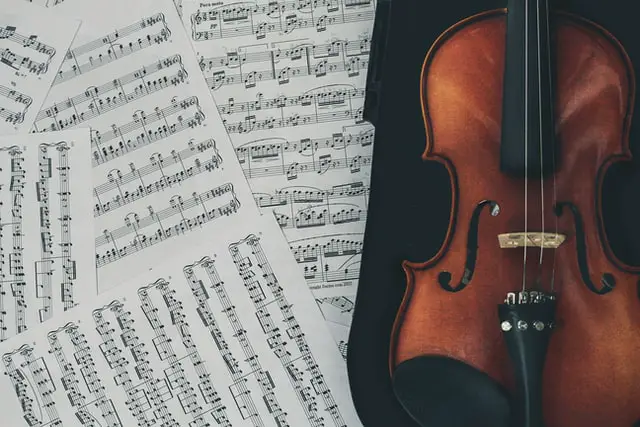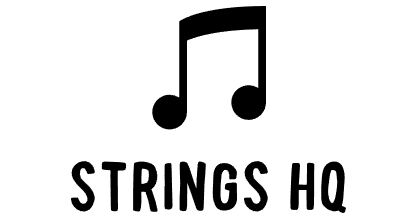The viola and violin don’t often play duets and it can be challenging to find the best duet music.
We’ve therefore put in hours of research to find the best 11 violin & viola duets. We’ve chosen from a variety of composers and presented varying difficulties to suit all players.

Table of Contents
1. Halvorsen’s Passacaglia for Violin and Viola
Johan Halvorsen, a Norwegian composer, and violinist, composed his Passacaglia for Violin and Viola in 1893.
The piece is based on Passacaille No. 6 in G minor by George Frederic Handel. It begins with both the violin and the viola playing together in a harmonical manner.
The violin would then slow down a little to give room for the viola where some romantic notes start to appear. The violin would act as a gentle background noise for a few seconds until the viola starts to slow down and give more music room for the violin.
The doubling between the violin and the viola continues until the piece ends after around seven minutes.
2. Mozart’s Duo for Violin and Viola in G major, K.423
When the word great is mentioned in music, Wolfgang Amadeus Mozart’s name always appears. His violin and viola duo in G major is a good example of his brilliance.
The piece is composed of three movements distributed over 17 minutes of pure virtuosity. The three movements are Allegro, Adagio, and Rondeau.
K.423 is one of Mozart’s lesser-known pieces but also one of his most charming. Mozart composed K.423 and K.424 in 1783 and both the violin and viola duets were intended to be a part of a six-piece collection.
3. Sibelius’ Duo With Violin and Viola in C Major
The Finnish composer Jean Sibelius composed his Duo with Violin and Viola in C Major sometime between 1891–1892.
Unlike Halvorsen’s Passacaglia for Violin and Viola which included a lot of doubling between the instruments, Sibelius’ duo focused more on the uniform harmonical play between the violin and the viola.
The piece is less than six minutes long but most of those six minutes is a synched play between the two instruments. To demonstrate how difficult it is to sync the violin and the viola for six minutes, try syncing your words with someone for a few minutes.
Check out a live demonstration of this duo here.
4. Haydn’s Hob VI:1 Duo for Violin & Viola in F Major
Violinist and composer Joseph Haydn gifted us with his Haydn’s Hob VI:1 duo in 1775. The piece is formed of three movements, Allegro moderato, Adagio, and Tempo di menuetto.
The first movement is a cheerful one that blends between fast notes and calm ones. The second movement is so different from the first one that you’d think it’s a different piece. The joy of the first movement is replaced by harmonic, slow, and relatively sad notes.
The final movement picks back on the first movement’s joyful pace until it ends beautifully.
Hear this piece here.
5. Spohr’s Violin and Viola in E Minor Op. 13
Despite being a duet between the violin and the viola, the violin takes over 70% of this piece.
Composed by German composer Louis Spohr, Spohr’s Violin and Viola in E Minor Op. 13 is a beautiful piece that lasts around 17 minutes.
Those 17 minutes have three movements, Allegro moderato, Adagio, and Tempo di Menuetto.
This piece is a good demonstration of how synched movements between the violin and the viola could produce a virtuous experience, especially in the first movement.
Check out the beauty of this piece in Belgium 2017 played by Noé Inui and Marc Sabbah.
6. Sharwenka’s Duo for Violin & Viola Op. 105
Sharwenka’s Duo for Violin & Viola Op. 105 was composed by the German composer and teacher, Ludwig Philipp Scharwenka in 1898.
This piece is relatively shorter than most pieces on our list with only 13 minutes of playtime. It contains two movements; Andante sostenuto (A minor) and Allegretto con spirito (A major.)
Because of the piano’s influence in the background, the piece was published under the name Piano Trio Op.105.
Sharwenka’s Duo for Violin & Viola Op. 105 was dedicated to a German violin player named Hermann Ritter. Ritter initially played the violin but his interest shifted slowly from the violin to the viola.
Have a look at this piece here.
7. Bruch’s Double Concerto for Violin and Viola in E minor
Max Bruch was a German composer and the one responsible for the Double Concerto for Violin and Viola in E minor. The piece is almost 20 minutes long and consists of three movements; Andante con moto, Allegro moderato, and Allegro molto.
Much like Halvorsen’s Passacaglia for Violin and Viola, there’s a lot of doubling between the violin and the viola in this piece. Especially in the second movement.
Bruch’s double concerto was portrayed by various artists. However, in our opinion, the performance of Pavel Milyukov and Maxim Rysanov stood out among the ones we found.
8. Pleyel’s Grand Duo for Violin and Viola in C Major Op. 69
Ignace Joseph Pleyel was an Austrian-born French composer who gifted us the violin and Viola Grand Duo.
The piece starts strong with a synonyms play of both instruments and then reduces both the noise and notes played per second. It then picks on again to repeat the beginning followed by the same reduction in the pace of the harmony.
The speed then picks up in the middle of the piece where the violin player plays a notable number of notes more than the viola player who then acts more as a background.
The lower and deeper sound of the viola continues to act as a resonance for the viola until the end of the piece.
The beginning of the first movement displays fantastic teamwork between the violin and viola players.
9. Martinů’s Three Madrigals for Violin and Viola
Bohuslav Martinů composed the Three Madrigals for violin and viola in 1950 as a dedication to Joseph and Lillian Fuchs.
The Three Madrigals was inspired by the Mozart Duos. They share the same three-movement form, virtuoso interplay, and imaginative textures. The name of the piece itself was inspired by the English madrigals.
The opening of the first movement, Poco allegro, contains a driving energy with an infectious bounce. The second movement, Poco andante, is a mix between soft trembling and trilling.
In the finale, Martinů switches to a humorous and vigorous folk music. The third movement is a harmonical search for a slow central contrast that feels like a mash-up of hoedown and Back invention.
Hyeyoon Park and Timothy Ridout played a wonderful display of The Three Madrigals in September 2020.
10. Mozart’s Sinfonia Concertante K.364
Mozart’s Sinfonia Concertante is arguably one of the best violin and viola duets out there. Throughout the whole piece, the violin and the viola are in a harmonic counterpoint.
The piece can be played using only a violin and a viola but its shine comes when an orchestra is accompanied. The violin and the viola would then seem like two birds who are flying in the background drawn by the orchestra.
There’s much to be heard from the viola in this piece. The viola player needs to be careful not to balance their performance and not overpower the violin. Mozart knew exactly where the limits of the viola were.
Sinfonia Concertante is a 30-minute-long piece that’s made of three movements. Allegro maestoso, Andante 3/4 in C minor, and Presto, 2/4. Watch this masterpiece here.
11. Kalliwoda’s Duet for Violin and Viola, Op. 208 No. 1
This piece was made by German violinist and composer, Johann Baptist Wenzel Kalliwoda. This duet focuses more on the violin while allowing the viola to harmonically switch between trailing the violin and echoing its notes.
The trailing is more obvious in the first movement until the second movement, Andante moderato, starts after six minutes.
In the second movement, both instruments start to play similar notes at the same time which enriches the auditory experience of the violin with the viola’s deeper noise.
The notes get louder and faster as you approach the fourth and last movement; Allegro risvegliato. The violin plays faster and louder notes while the viola stops trailing and starts playing ‘hidden’ notes in between the violin notes.
The viola player must time his notes perfectly not to disrupt the violin’s experience. Here’s what the duet sounds like if you’re interested.
You’ve Reached the End
Those were our 11 Great Violin and Viola Duets for today. From Mozart’s genius composing Halvorsen’s romantic music, the list is guaranteed to give you a wide array of classical music to satisfy each taste.
Blending the violin and the viola isn’t an easy task, but those composers have done it well enough for violin and viola players to replicate them throughout history.
